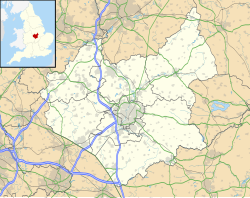| Breedon Church | |
|---|---|
| The Church of St Mary and St Hardulph, Breedon on the Hill | |
 | |
| 52°48′22″N1°24′0″W / 52.80611°N 1.40000°W | |
| OS grid reference | SK 406 234 |
| Country | England |
| Denomination | Church of England |
| Churchmanship | Broad Church |
| History | |
| Dedication | St Mary and St Hardulph |
| Architecture | |
| Heritage designation | Grade I listed building |
| Architectural type | English Gothic |
| Administration | |
| Province | Canterbury |
| Diocese | Diocese of Leicester |
| Parish | Breedon on the Hill |
The Priory Church of St Mary and St Hardulph is the Church of England parish church of Breedon on the Hill, Leicestershire, England. The church has also been known as Breedon Priory.
Contents
- History
- Breedon Minster
- Breedon Priory
- Later history
- The church
- Anglo-Saxon carvings
- Shirley monuments
- Pews
- Churchyard
- St Hardulf
- Church organisation
- See also
- References
- Cited texts
The present church, which had been preceded by a minster (an Anglo-Saxon monastery) from the 7th century, contains the largest collection, and some of the finest examples, of Anglo-Saxon sculptures. It also contains a notable family pew and Renaissance-era church monuments to the Shirley family, who bought the manor of Breedon after it was surrendered to the Crown in 1539 during the Dissolution of the Monasteries. The largest of these monuments is for Sir George Shirley. It was made over 20 years before his death and includes a life-sized skeleton carved in alabaster. [1]
The church stands on the top of Breedon Hill, within the remains of an Iron Age hill fort called The Bulwarks. The hill is flanked to the south by the 400 houses of Breedon on the Hill village, and encroached on the east by Breedon Quarry. [2] Breedon church is a nationally important building, with a Grade I listing for its exceptional architectural interest.













